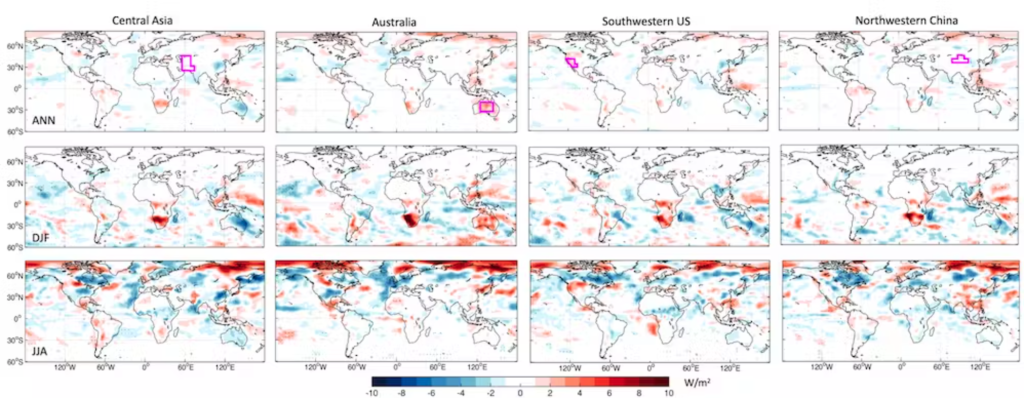
Harnessing the boundless energy of the Sun offers an effectively unlimited resource. Unlike finite sources like coal or gas, utilizing solar power doesn’t restrict others from tapping into the abundant sunshine at their disposal.
However, the complete narrative reveals a different aspect. Once solar farms reach a certain scale, they possess the potential to influence the surrounding weather and, consequently, impact the overall climate.
Through our recent study, we’ve examined the potential impact of climate-influencing solar farms on solar power generation in different parts of the world.
We’re aware that solar power is influenced by weather conditions, leading to fluctuations in output throughout the days and seasons. Sunlight obstruction from clouds, rain, snow, and fog can impact solar panel efficiency. On overcast days, output may decrease by 75%, while efficiency also diminishes in high temperatures.
Over the long term, climate change has the potential to influence the cloud cover in specific regions, impacting their solar power generation. Northern Europe is expected to experience a solar reduction, whereas a modest increase in available solar radiation is anticipated for the rest of Europe, the US east coast, and northern China.
Should we ever construct massive solar farms covering entire countries and continents, they could potentially exert a comparable influence.
In our latest research, we employed a computer program to simulate the Earth system. This modeling helped us assess the potential impact on global solar power generation if expansive solar farms, covering 20% of the Sahara, were to be implemented.
A photovoltaic (PV) solar panel, being dark in color, absorbs significantly more heat compared to reflective desert sand. While a portion of the energy is converted into electricity, a substantial amount contributes to the panel’s heating. With millions of these panels clustered together, the entire area experiences warming.
Our simulations indicate that if these solar panels were situated in the Sahara, the resultant heat could potentially reshape global climate patterns. This could redirect rainfall away from the tropics, leading to a rejuvenation of the desert, much like its state around 5,000 years ago.
Consequently, this would impact cloud cover patterns and the global generation of solar energy.
Regions that would experience increased cloud cover, reducing solar power generation, encompassing the Middle East, southern Europe, India, eastern China, Australia, and the US southwest. Conversely, areas set to generate more solar power include Central and South America, the Caribbean, Central and Eastern US, Scandinavia, and South Africa.
How global solar potential would be affected:

We observed a comparable scenario in our simulations when examining the impacts of extensive solar farms in other high-temperature zones such as Central Asia, Australia, the southwestern US, and northwestern China. In each case, it resulted in climate changes in other regions.
As an example, expansive solar farms across the Australian outback would increase sunlight in South Africa but lead to more cloud cover in the UK, especially during the summer months.
If huge solar farms were installed in other drylands:

It’s essential to note some considerations. Any shifts would be minimal, typically a few percentage points – no matter how much solar power infrastructure is developed, Scandinavia will maintain its cool and cloudy climate, and Australia will remain hot and sunny.
Moreover, it’s crucial to recognize that these effects are based on theoretical scenarios. For example, our Sahara simulation considered covering 20% of the entire desert with PV solar farms. While there have been ambitious proposals, the realization of such large-scale projects is unlikely in the foreseeable future.
Should the covered area be scaled down to a more reasonable (though still improbable) 5% of the Sahara, the overall global effects become largely insignificant.
Why this thought experiment matters
In a prospective scenario where nearly every region commits to increased solar projects, relying more on them, the dynamics of solar energy resources could indeed mold the energy landscape. This could give rise to an intricate network of dependencies, rivalries, and opportunities.
The strategic deployment of solar project construction by specific nations could wield considerable influence, reshaping the potential for solar generation well beyond their borders.
This underscores the importance of promoting collaboration among nations, guaranteeing the fair distribution of solar energy benefits globally.
Through the exchange of knowledge and collaborative efforts in planning the spatial layout of upcoming large-scale solar initiatives, nations can create and execute equitable, sustainable energy solutions. This approach helps prevent unintentional risks to solar power production in distant locations.
This content has been reissued from The Conversation under the terms of a Creative Commons license.





